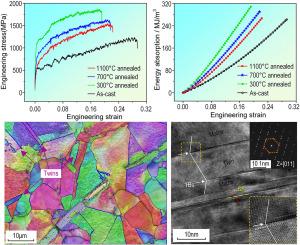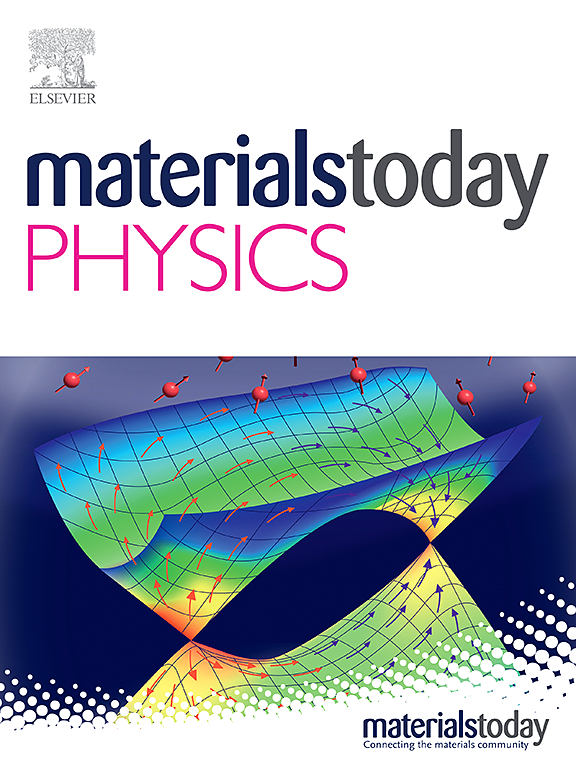Low-temperature annealing induces superior shock-resistant performance in FeCoCrNiCu high-entropy alloy
IF 10
2区 材料科学
Q1 MATERIALS SCIENCE, MULTIDISCIPLINARY
引用次数: 0
Abstract
By virtue of ultrahigh hardness, excellent wear resistance, and superior thermal stability, FeCoCrNiCu high-entropy alloys (HEAs) have promise for a wide range of structural applications. However, the focus of existing studies has been on quasi-static or static conditions, while a fundamental understanding is still limited to the mechanical response and deformation behavior under dynamic loading. Here, the dynamic compression test was carried out to explore the dynamic response mechanism of the FeCoCrNiCu HEA in terms of annealing temperature. Low-temperature annealing was confirmed to significantly improve the dynamic strength. In particular, the yield strength and final flow stress of the annealed HEAs at 300 °C were demonstrated to be as high as 1178.2 MPa and 1797.9 MPa, which was 113.6 % and 54.5 % higher than that of the as-cast counterparts, respectively. Our results revealed that this substantial increase in strength came from a combination of mechanisms, involving dislocation, twinning and fine grain strengthening. In addition, the energy absorption per unit volume of HEAs annealed at 300 °C at maximum strain was measured to be as high as 308.05 MJ/m3 (only 262.55 MJ/m3 for the as-cast counterpart), indicating excellent energy absorption capability. Our investigation reveals the dynamic deformation behaviors and mechanisms of FeCoCrNiCu HEAs, providing valuable guidance for designing and developing HEAs with excellent mechanical properties under dynamic loading.


低温退火使FeCoCrNiCu高熵合金具有优异的抗冲击性能
FeCoCrNiCu高熵合金(HEAs)具有超高硬度、优异的耐磨性和优异的热稳定性,具有广泛的结构应用前景。然而,现有研究的重点是准静态或静态条件,而基本的理解仍然局限于动态载荷下的力学响应和变形行为。通过动态压缩试验,探索FeCoCrNiCu HEA在退火温度下的动态响应机制。低温退火可显著提高合金的动态强度。其中,退火后的HEAs在300℃时的屈服强度和终流变应力分别达到1178.2 MPa和1797.9 MPa,分别比铸态高113.6%和54.5%。我们的研究结果表明,这种强度的大幅提高是由位错、孪晶和细晶粒强化等多种机制共同作用的结果。此外,在最大应变下300℃退火的HEAs单位体积吸能高达308.05 MJ/m3(铸态HEAs仅为262.55 MJ/m3),具有良好的吸能能力。本研究揭示了FeCoCrNiCu HEAs的动态变形行为及其机理,为设计和开发具有优异力学性能的HEAs提供了有价值的指导。
本文章由计算机程序翻译,如有差异,请以英文原文为准。
求助全文
约1分钟内获得全文
求助全文
来源期刊

Materials Today Physics
Materials Science-General Materials Science
CiteScore
14.00
自引率
7.80%
发文量
284
审稿时长
15 days
期刊介绍:
Materials Today Physics is a multi-disciplinary journal focused on the physics of materials, encompassing both the physical properties and materials synthesis. Operating at the interface of physics and materials science, this journal covers one of the largest and most dynamic fields within physical science. The forefront research in materials physics is driving advancements in new materials, uncovering new physics, and fostering novel applications at an unprecedented pace.
 求助内容:
求助内容: 应助结果提醒方式:
应助结果提醒方式:


